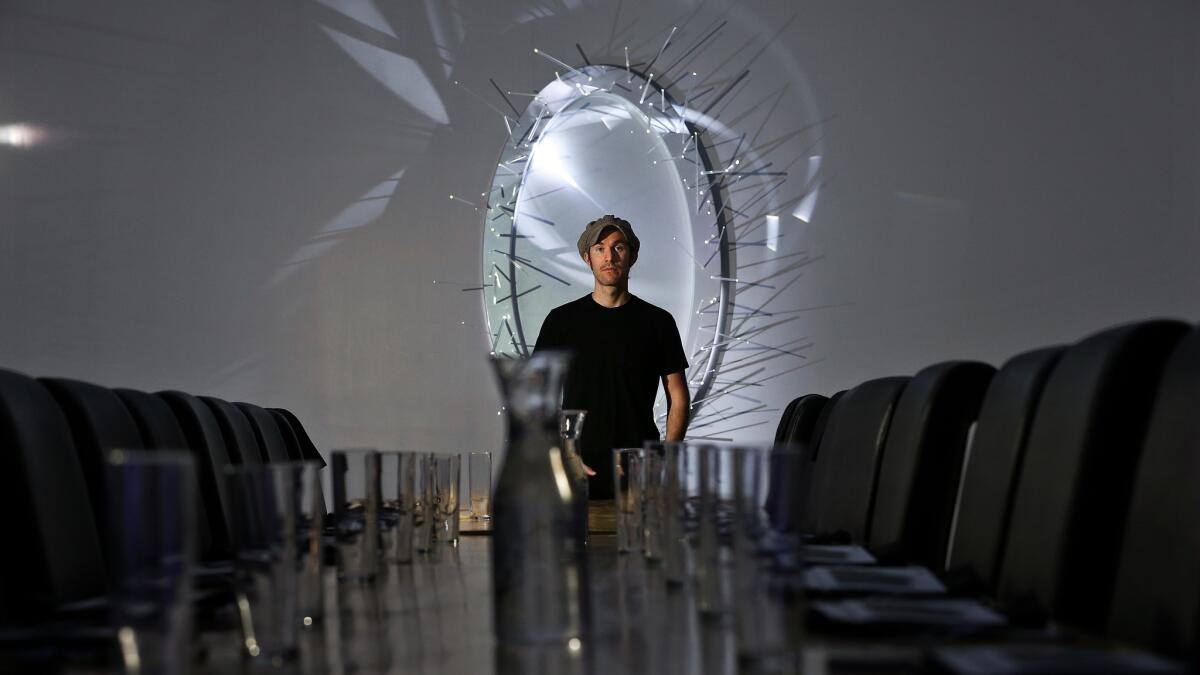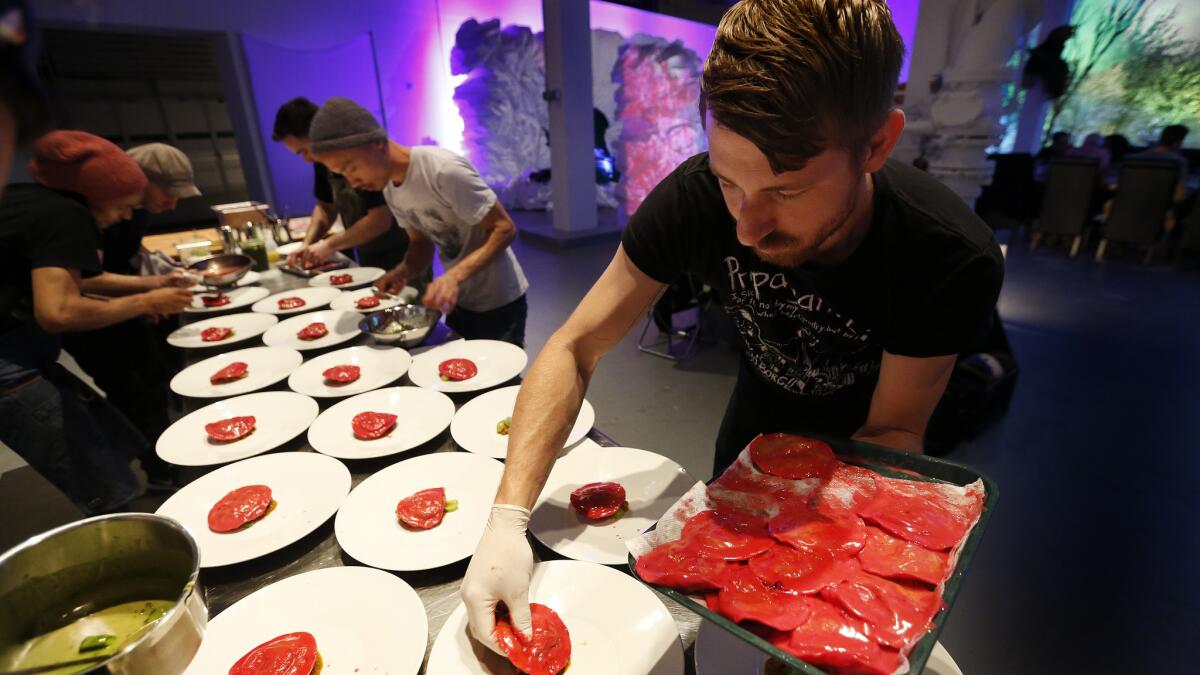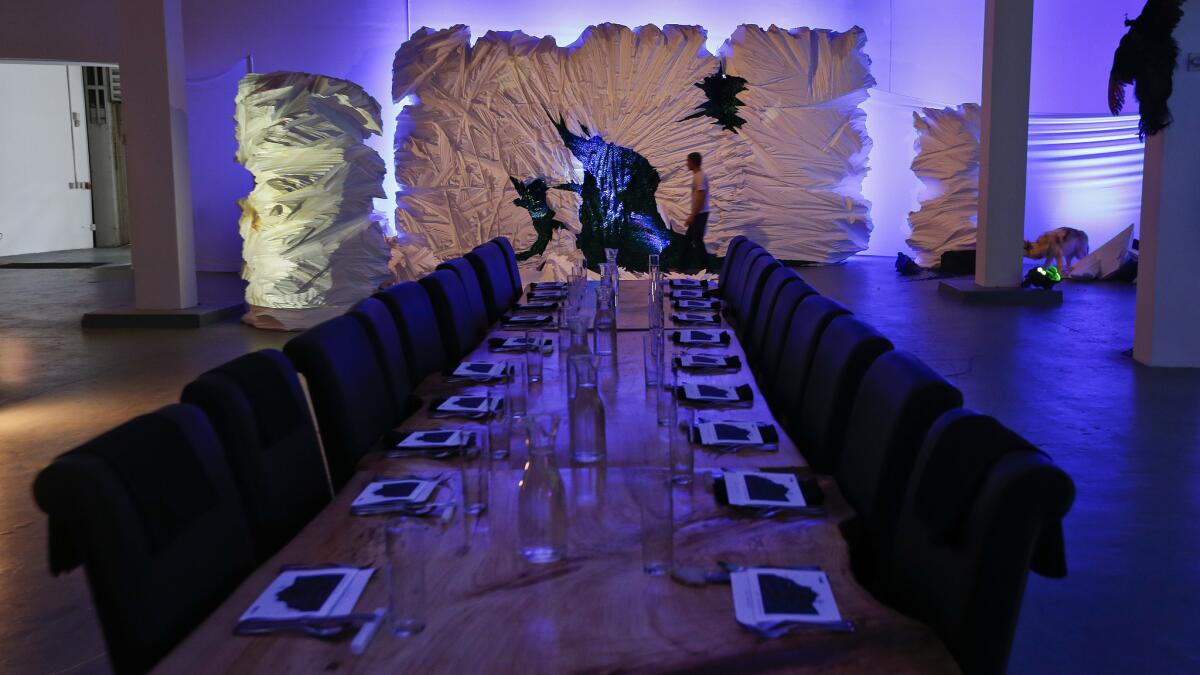Column: Wolvesmouth at MOCA: Craig Thornton puts his art on a plate, and then you eat it
For most of us, “dinner” means something quick, rustled up at the end of a long day. For Craig Thornton, the man behind the unusual underground Los Angeles supper club Wolvesmouth, dinner is art — literally.
The chef is known for his wild pop-ups, where he produces meals that combine over-the-top installation (a dining area overlooking a three-dimensional landscape composed of coyote pelts) with dishes in an array of bold textures and electric colors (crunchy blue meringues and viscous, blood-red sauces).
Thornton is currently in residence at the Museum of Contemporary Art’s Little Tokyo location in downtown Los Angeles, where three nights a week, he and a crew of six dish up a nine-course art-dinner to patrons who are willing to dip into a little bit of experimentation while seated at a dinner table surrounded by a sculptural installation built out of Styrofoam and taxidermy.
“I see him as an artist who is neither a visual artist, nor a performance artist, nor a chef, but all of that together,” said MOCA director Philippe Vergne, who first experienced one of Thornton’s meals at a pop-up space in a Glendale warehouse before inviting him to the museum. “I love this idea that it’s art that you experience through your mouth.”

Thornton likens his meals to works in which he paints with colors and with taste. The first course, for example — a slice of seared ribeye presented under an intensely purple sauce made with squid ink — is inspired by his coyote pelt installation, which touches on themes of natural and industrial decay. But bite into it and you also get the fresh taste of kimchi and Asian pear, which are layered into the dish.
“It’s like a painting of black clouds and the taste is the sun shining through those clouds,” Thornton said. “It looks murky, but it has this brightness to it. I think of it as the equivalent of painting a highlight, except it’s not a visual highlight. It’s a highlight through taste.”
Another dish, composed of lamb ragu and a disconcertingly red beet raviolo, evokes a still-warm heart that has just been extricated from its body. It’s a visceral sight that nods to a nearby wall sculpture, “Truncated Divinity,” a spiked mirror that reads like an abstract crown of thorns.
“You look at it and it looks like a beating heart,” Thornton collaborator Ben Miller said of the dish. “But then you eat it and it feels lighter. The ravioli has beet and mint. It’s not what you’re expecting.”

The colors are so intense it made me wish that Thornton had put a spotlight over his dining table, because the colors of the food are currently washed out by the installation’s dim light.
“Wolvesmouth : Taxa,” as Thornton’s MOCA pop-up is called, is on the decadent end of the food-art spectrum. (It does, after all, cost $225 per person to attend.) The sculptures are hardly subtle. “Dissonance and the State of Being Content,” a forest scene made with the pelts of dozens of coyote heads, looks like a natural history museum diorama gone wildly apocalyptic.
The dishes, likewise, lean toward the rococo — each crafted from a long list of ingredients that are earnestly monologued by Thornton and his colleagues. A pork belly dish is a veritable rainbow of items, including green beens, a strawberry-piquillo gazpacho, parsley oil, leeks and candied peanuts. The ribeye that kicks off the feast also includes purple cabbage, creamed kimchi, Asian pears, crispy shallots, beef tongue and a sabayon made of squid ink, all organized in geological layers.
All of this means that, in some cases, the flavors get muddled. An overly sweet butterscotch-and-blueberry crepe dessert loses focus amid the panoply of fixings. But for Thornton, going overboard is part of the point.
“I don’t want things to have some pleasant look,” he explained. “I really like a punchy vibrancy. A lot of American food is brown. It’s all caramelization and heavy brown-ness ... it all ends up tasting the same.”

In a way, Thornton’s dishes are a reaction to all the farm-to-table freshness that has become the cliché of contemporary fine dining. “It gets to the point where everything is so stripped down and so simplified, it becomes monotonous,” he said. “I want people to have that feeling of, ‘Oh, I can’t replicate this.’”
In their physical presence the dishes are indeed impactful — a strange and deeply saturated palette of purples, lavenders, greens, pinks and blues.
For Trebor Healy, a Los Angeles-based poet, who happened to sit across from me the night I attended Wolvesmouth, the attention to presentation is what makes the work so intriguing.
“So much food, it’s plain and you just shovel it in, like, fuel,” he said. “But when it’s beautiful, you stop, you look at it. It really makes you think.”
Herewith, a photographic tour of Wolvesmouth’s nine-course extravaganza:
It’s like a painting of black clouds and the taste is the sun shining through those clouds.
— Chef Craig Thornton
I see him as an artist who is neither a visual artist, nor a performance artist, nor a chef, but all of that together. ... It’s art that you experience through your mouth.
— MOCA director Philippe Vergne
It looks like a beating heart. But then you eat it and it feels light. ... It’s not what you’re expecting.
— Thornton collaborator Ben Miller on Wolvesmouth’s beet raviolo
Where: MOCA’s Geffen Contemporary, 152 N. Central Ave., Los Angeles
When: Thursdays, Fridays and Saturdays through July 8.
Tickets: $225 per person, reservations essential.
Info: moca.org and wolvesmouth.com.
ALSO
How Southern California became the backdrop to an opera about a ‘hysterical’ woman
Find me on Twitter @cmonstah
More to Read
The biggest entertainment stories
Get our big stories about Hollywood, film, television, music, arts, culture and more right in your inbox as soon as they publish.
You may occasionally receive promotional content from the Los Angeles Times.











